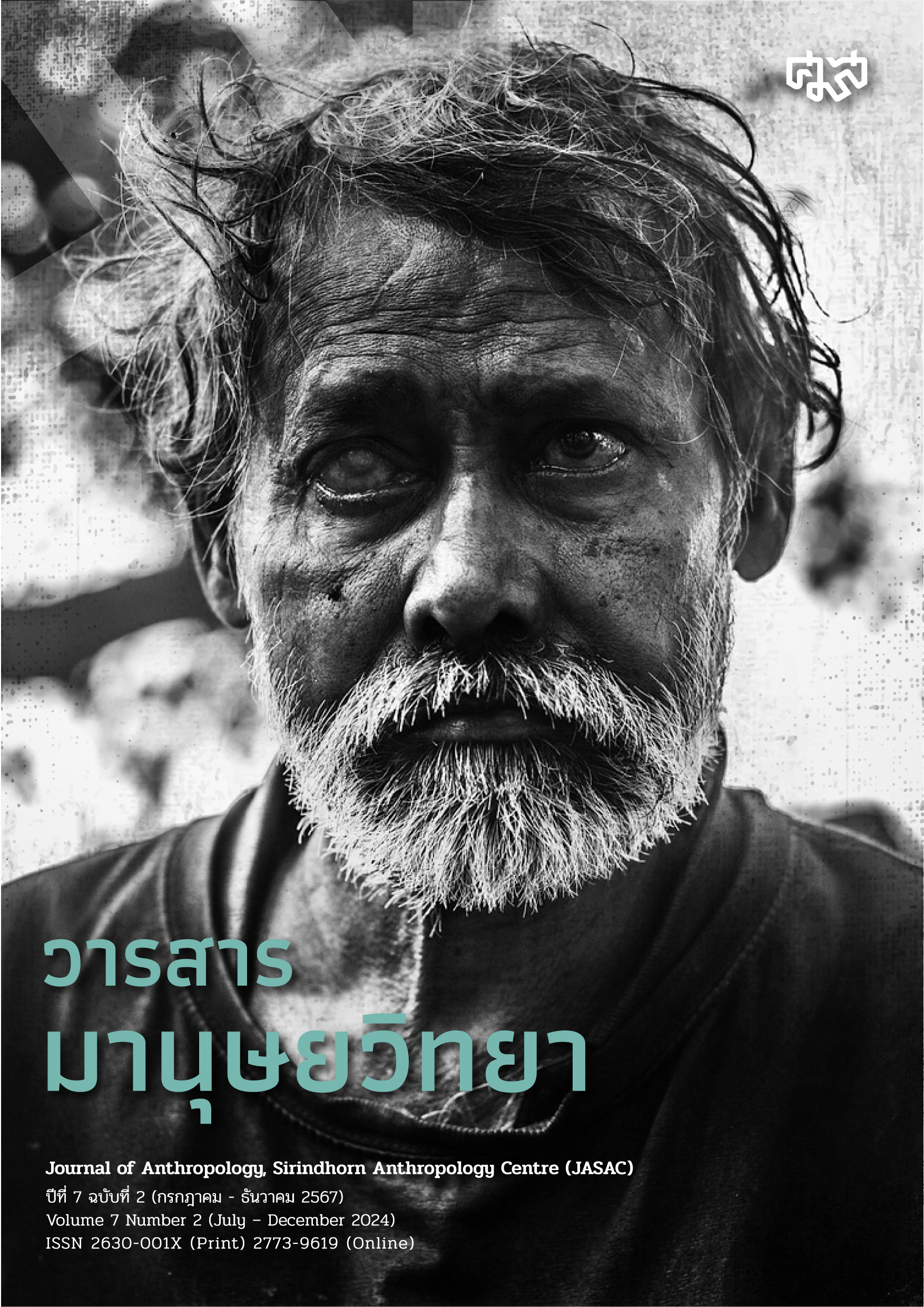ครัวไทด่าน : “พื้นที่” และ “ประสบการณ์” ในมุมมอง “มานุษยวิทยาครัว”
Main Article Content
บทคัดย่อ
บทความนี้มีจุดประสงค์หลักเพื่อ 1) ศึกษาครัวไทด่านในเชิงพื้นว่ามีนัยยะในมิติสังคมและวัฒนธรรมอย่างไร และ 2) ศึกษาครัวไทด่านโดยใช้มุมมองมานุษยวิทยาครัวว่า “คน” และ “ครัว” มีความสัมพันธ์กันอย่างไร ระเบียบวิธีศึกษาประกอบด้วยการสังเคราะห์เอกสารที่เกี่ยวข้องกับประเด็นมานุษยวิทยาครัว ครัวและอาหารไทด่าน รวมถึงการลงภาคสนามเพื่อสังเกตการณ์อย่างมีส่วนร่วมและสัมภาษณ์เชิงลึก พื้นที่ศึกษาคือหมู่บ้านในอำเภอด่านซ้าย จังหวัดเลย ซึ่งเป็นสังคมเกษตร มีฐานทรัพยากรอาหารที่หลากหลายและมีวัฒนธรรมเฉพาะ โดยเฉพาะรูปแบบครัวและอาหาร ผลการศึกษาเผยให้เห็นว่า ครัวไทด่านมีการจัดวางตำแหน่งแห่งที่ไม่เพียงแต่มีความสำคัญในเชิงกายภาพ หากแต่ยังเป็นพื้นที่ของประสบการณ์ที่สะท้อนให้เห็นจุดเริ่มต้นของการปรุงแต่งอาหารที่มี “คน” และ “ครัว” สัมพันธ์ต่อกัน รวมถึงยังสะท้อนการเมืองในความสัมพันธ์ทางสังคม: บทบาททางเพศ การจัดระเบียบมื้ออาหาร และการขัดเกลาทางสังคม นอกจากนี้ ยังทำให้เกิดคววามเข้าใจแหล่งที่มาของอาหาร การปรุงแต่งและวิถีทำกิน
Article Details

อนุญาตภายใต้เงื่อนไข Creative Commons Attribution-NonCommercial-NoDerivatives 4.0 International License.
ลิขสิทธิ์@ของวารสารมานุษยวิทยา
ศูนย์มานุษยวิทยาสิรินธร (องค์การมหาชน), กรุงเทพฯ, ประเทศไทย
ข้อมูลเพิ่มเติม:
https://creativecommons.org/licenses/by-nc-nd/4.0/
เอกสารอ้างอิง
กุลกาญจน์ แย้มนุ่น. (2547). ครัวไทยภาคกลาง: คุณลักษณะของที่ว่างและความหมาย. วิทยานิพนธ์สถาปัตยกรรมศาสตรมหาบัณฑิต. จุฬาลงกรณ์มหาวิทยาลัย.
ฤทัย ใจจงรัก. (2518). เรือนไทยเดิม: โครงการค้นคว้าวิจัย. คณะสถาปัตยกรรมศาสตร์ มหาวิทยาลัยศิลปากร.
เอกรินทร์ พึ่งประชา และคณะ. (2555). โครงการวิจัยภูมิปัญญาท้องถิ่นในการจัดการระบบอาหารชุมชนกรณีหมู่บ้านในอำเภอด่านซ้าย จังหวัดเลย. สำนักงานกองทุนสนับสนุนการวิจัย.
เอกรินทร์ พึ่งประชาและคณะ. (2560). การสร้างศักยภาพของครัวเรือนเพื่อความมั่นคงทางอาหารของชุมชน กรณีศึกษาบ้านก้างปลา อ.ด่านซ้าย จ.เลย. สำนักงานกองทุนสนับสนุนการวิจัย.
เอกรินทร์ พึ่งประชาและคณะ. (2564). การขับเคลื่อนเกษตรผสมผสาน เพื่อลดความเสี่ยงและลดภาระหนี้สินของเกษตรกรอย่างยั่งยืน. สำนักงานกองทุนสนับสนุนการวิจัย.
Bourdieu, P., 1970. The Berber house or the world reversed. Social Science Information, [online] 9(2), pp.151-170. Available at: <https://doi.org/10.1177/053901847000900213> [Accessed 7 January 2024].
Cai, H. (2001). A Society without Fathers or Husbands: The Na of China. New York: Zone Books.
Ceccarini, R. (2010). “Food Studies and Sociology: A Review Focusing on Japan.” AGLOS. 1: 1-17. Graduate School of Global Studies, Sophia University.
Clyang, E. and Khoo-Lattimore, C. (2014). The Pleasure and Anxiety of Eating. South East Queensland: Griffith University Press.
Coveney, J. (2000). Food Morals and Meaning: The Pleasure and Anxiety of Eating. Second Edition. New York: Routledge.
DeVault M. L. (1994). Feeding the Family: The Social Organization of Caring as Gendered Work. Chicago University of Chicago Press.
Duruz, J. and Khoo, G. C. (2015). Eating Together Food, Space, and Identity in Malaysia andSingapore. New York: Rowman & Littlefield.
Fieldhouse, P. (1995). Food and Nutrition, Customs and Culture. London: Chapman and Hall.
Fox, R. (2015). Food and Eating: An Anthropological Perspective. Retrieved: http://www.sirc.org/publik/food_and_eating_0.html
Harshman, D., 2016. Cooking up a New Everyday: Communal Kitchens in the Revolutionary Era, 1890–1935. Revolutionary Russia, [online] 29(2): 211-233. Available at: <https://doi.org/10.1080/09546545.2016.1243616> [Accessed 5 January 2023].
Inness, S.A. (2001). Dinner Roles. American Women and Culinary Culture. Iowa City: University of Iowa Press.
Kraidy, M.M. (2005). Hybridity: The Cultural Logic of Globalization. Philadelphia: Temple University Press.
Leach, M. (1991). Rainforest Relations, Gender and Resource Use among the Mende of Gola,Sierra Leone. Edinburgh: Edinburgh University Press.
Lévi-Strauss, C. (1969). The Raw and the Cooked. Introduction to a Science of Mythology.New York: Harper & Row.
Lukanuski, M. (1998). “A Place at the Counter: The Onus of Oneness,” In Eating Culture, edited by Ron and Brian Seitz. Albany: State University of New York Press.
Meah, A. and Jackson, P. (2015). Re-imagining the kitchen as a site of memory. Social & Cultural Geography. 17(4), 511-532.
Mintz, S. (2006). “Food, History and Globalization,” Journal of Chinese Dietary Culture. 2 (1): 1-22 (In Chinese translation: 23- 38.)
Parr, J., 2002. Editor's Introduction: Modern Kitchen, Good Home, Strong Nation. Technology and Culture, [online] 43(4), pp.657-667.
Available at: <https://www.jstor.org/stable/25148006> [Accessed 5 January 2022].
Pottier, J. (1999). Anthropology of Food: The Social Dynamics of Food Security. Anthropologyat SOAS.
Pollan, M. (2013). Cooked: A Natural History of Transformation. New York: The Penguin Press.
Short, F. (2006). Kitchen Secrets: The Meaning of Cooking in Everyday Life. Oxford: Berg.Samanani, F. and Lenhard, J., 2019. House and home. In: Cambridge Encyclopedia. [online] Available at: https://www.anthroencyclopedia.com/entry/house-and-home[Accessed 4 January 2024]
Symons, M., 1994. Simmel's gastronomic sociology: An overlooked essay. Food and Foodways,
(4): 333-351.


